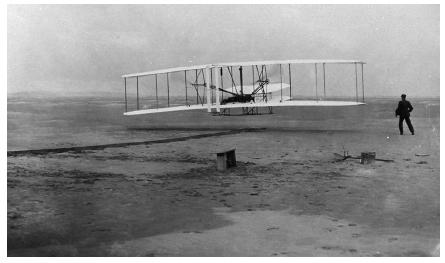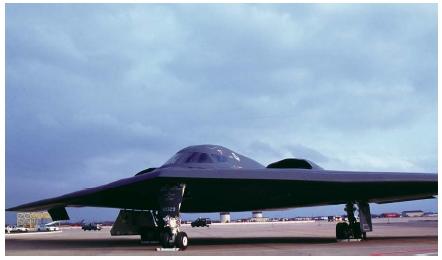Aircraft
An aircraft is a machine used for traveling through the atmosphere. There are two types of aircraft: the first type are known as lighter-than-air crafts, which are supported by their own buoyancy or ability to float. The second are known as heavier-than-air crafts, which require the use of some sort of engine to propel them through the air.
Early theories of air travel
Humans have dreamed of flying like birds for centuries. A Chinese myth dating to at least 1500 B.C. tells of men flying through the air in a carriage driven by something very much like a modern propeller. The Greek legend of Daedalus and Icarus is closer to the image that early humans had of flight, however. According to that myth, Daedalus constructed a set of wings that he attached to his son, Icarus, as a means of escaping from the island of Crete. Icarus flew so high, however, that the wax holding the wings to his body melted, and he fell to his death.
For more than 20 centuries, humans repeated Daedalus' experiment, with ever more sophisticated attempts to duplicate the flight of birds. All such attempts failed, however, as inventors failed to recognize that the power generated by a single human could never be sufficient to lift a person off Earth's surface.
Lighter-than-air craft
Successful flight was not possible until humans understood and made use of the concept of buoyancy. Buoyancy refers to the ability of an object to float or rise in a medium (such as water or air) because the object's density is less than that of the medium. A cork floats in water, for example, because the cork is less dense than the water. Buoyant aircraft became possible when scientists discovered that certain gases—especially hydrogen and helium—are less dense than air. Heated air is also less dense than cooler air. Thus, a container filled with hydrogen, helium, or heated air will rise in normal air.
Balloons were the first aircraft to make use of this principle. The fathers of ballooning are sometimes said to be the Montgolfier brothers, Joseph and Jacques. In 1783, after a series of experiments, the brothers constructed a balloon large enough to carry two humans into the atmosphere, the first manned aircraft.
Balloons, however, are dependent on the wind for speed and direction. In the nineteenth century, cigar-shaped balloons were designed with propellers driven by steam engines to give greater control. These modified balloons came to be known as airships. The father of the modern rigid airship, known as a dirigible, is generally said to be German count Ferdinand von Zeppelin. Zeppelin's hydrogen-filled dirigible had a rigid aluminum frame over which a cloth skin was stretched. Able to be steered with complete control, Zeppelin-styled dirigibles transported more than 10,000 passengers by 1914.

Words to Know
Airship: Cigar-shaped balloon that uses a steering and propulsion system.
Blimp: Airship without a rigid framework that often uses helium gas as its lifting agent.
Dirigible: Airship that has a rigid frame covered with fabric and uses hydrogen or helium gas as its lifting agent.
Drag: A force of resistance caused by the movement of an aircraft through the air, such as the friction that develops between air and the aircraft body.
Glider: A motorless aircraft, also known as a sailplane, that remains in the air by riding on rising currents of air.
Jet engine: An engine that obtains its power from burning a fuel within the engine, creating a backward thrust of gases that simultaneously pushes the engine forward.
Lift: Upper force on the wings of an aircraft created by differences in air pressure on top of and underneath the wings.
Pitch: Tendency of an aircraft to rotate in a forward or backward direction, tail-over-nose, or vice versa.
Roll: Tendency of an aircraft to twist vertically around its body, the right wing sliding upward and the left wing downward, or vice versa.
Thrust: Forward force on an aircraft provided by the aircraft's power system.
Yaw: Tendency of an aircraft to rotate in a horizontal motion, with the left wing forward and the right wing backward, or vice versa.
Dirigibles filled with highly flammable hydrogen gas presented one terrifying possibility: they might explode. This fear was realized in 1937 when the dirigible Hindenburg exploded while attempting to moor in New Jersey, killing 36 people. Although later dirigibles were designed to fly with nonflammable helium, they never really regained popularity. Today, nonrigid airships using helium gas, known as blimps, are widely used for advertising and television purposes. The Goodyear blimp and its cousins have now become familiar sights at outdoor sporting events all over the United States.
Heavier-than-air craft
The father of heavier-than-air craft is said to be English scientist George Cayley (1773–1857). Cayley's research into flight laid the foundations of the modern science of aerodynamics, the study of the forces experienced by an object flying through the air. In 1853, he constructed his first working aircraft, a glider.
Gliders. A glider—also known as a sailplane—differs from a modern airplane only in that it has no power source of its own. Instead, it uses natural air movements such as updrafts and winds for propulsion and maneuvering. Gliders have very large wings, are made of the lightest possible material, and have extremely smooth surfaces. Any protrusion on the surface can produce friction that interferes with successful maneuvering. Properly designed gliders can remain in the air for hours and can travel at speeds of up to 150 miles per hour (240 kilometers per hour) using only natural updrafts.
Four fundamental aerodynamic forces
Modern aviation is said to have begun on December 17, 1903, at Kitty Hawk, North Carolina. Wilbur and Orville Wright, two bicycle makers from Dayton, Ohio, flew the world's first manned, powered, heavier-than-air craft. The steerable biplane (double-winged aircraft), with a gasoline engine and two propellers, remained in the air a total of only 12 seconds and covered only 120 feet (37 meters).
The problems that the Wright brothers had to solve in the early 1900s were essentially the same as those confronting aeronautical engineers in the late 1900s. In order to make a heavier-than-air machine fly, four factors have to be taken into consideration: weight, lift, thrust, and drag.
Weight and lift. Weight is caused by the pull of Earth's gravity on the airplane. To counteract this force, the plane must have a means of lift, or a force equal and opposite in direction to the pull of gravity. Aeronautical engineers know that the more quickly air moves over a surface, the less pressure it exerts on that surface. This is why the top and bottom surface of airplane wings are not identical. The top surface of a wing is designed to have a slightly curved shape, like half of a tear drop. The bottom surface of the same wing has a perfectly flat shape.
When air passes over a wing of this design, it moves faster and exerts less pressure on the top of the wing than it does on the bottom. Since the pressure under the wing is greater than the pressure on top of the wing, air tends to push upward on the wing, raising the airplane off the ground. Wing size and air speed combine to play a factor in this lift. The larger the wing, the greater the total force exerted on the bottom of the wing, giving greater lift. And the faster the air moves over a wing, the less pressure it exerts on top, also giving greater lift.
Thrust and drag. In addition to strong winds blowing over its wings, an airplane needs a forward thrust in order to move forward at a high rate of speed. The forward thrust for the aircraft comes from one of two sources: a rotating propeller blade powered by some kind of engine or a rocket engine.
The forward thrust provided by a propeller can be explained in exactly the same way as the lift on a wing. The propeller is shaped like a wing, with a rounded forward surface and a flat back surface. As the propeller rotates, air passes over its forward surface faster than it does over its back surface. As a result, the pressure on the forward surface is less than it is on the back, and the propeller is driven forward, carrying the airplane along with it.

The term drag refers to any factor that tends to slow down the forward movement of an aircraft. The most obvious type of drag is friction drag, a retarding force that results simply from the movement of an airplane through air. As air travels over an airplane wing, it does not travel smoothly, but tends to break apart and form eddies and currents that cause a drag on the airplane. One of the great challenges facing aeronautical engineers is to design aircraft in which all forms of drag are reduced to a minimum.
Aircraft stability
In flight, an airplane is subject to three major types of movements that, in the extreme, might cause it to crash: pitch, yaw, and roll. Pitch occurs when the nose of an airplane unexpectedly moves up or down. The horizontal tail at the back of an airplane body helps to prevent pitching. Yaw occurs when one wing unexpectedly moves forward while the other moves backward. Yawing is prevented partly by means of the vertical tail at the back of the airplane. Roll occurs when one wing unexpectedly moves upward while the other moves downward. Roll is prevented partly by having the outer edges of the wings tipped upward.
Jet engines
Until the 1940s, the only system available for powering aircraft was the piston-driven propeller engine. At the very end of World War II (1939–45), German scientists produced an entirely new type of power system, the jet engine. The center of the engine contains the elements necessary for its operation. Compressed air is mixed with a flow of fuel and ignited in a combustion chamber. Heated gases are formed, which push out of the rear of the engine. As the gases leave the engine, they also turn a turbine that compresses incoming air to begin the process once again.
The principle on which the jet engine operates was first developed by English physicist and mathematician Isaac Newton in the seventeenth century. According to Newton's third law of motion, for every action there is an equal and opposite reaction. In the jet engine, the action is the surge of burned gases flowing out of the back of the engine. The reaction to that stream of hot gases is a forward push that moves the engine—and the wing and airplane to which it is attached—in a forward direction. Because the exiting gases turn a turbine as well as power the engine, a jet of this kind is also known as a turbojet.
[ See also Aerodynamics ; Balloon ; Buoyancy ; Jet engine ; Radar ]
god bless and have a nice day :)